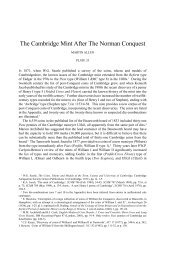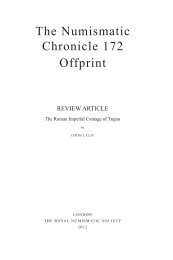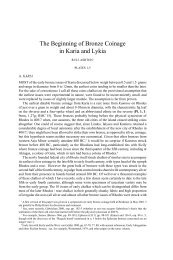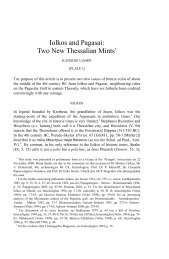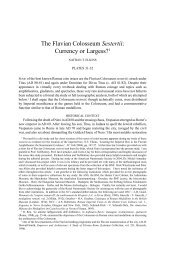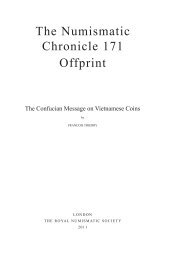The Numismatic Chronicle 171 Offprint - Royal Numismatic Society
The Numismatic Chronicle 171 Offprint - Royal Numismatic Society
The Numismatic Chronicle 171 Offprint - Royal Numismatic Society
You also want an ePaper? Increase the reach of your titles
YUMPU automatically turns print PDFs into web optimized ePapers that Google loves.
104<br />
RICHARD SCHAEFER and ANDREW McCABE<br />
6. Small change issue, non-RRC 113 star-before quadrans (Figs 12, 13)<br />
<strong>The</strong>re exist many more numerous star-before quadrantes which cannot to be assigned<br />
to RRC 113. <strong>The</strong> examples illustrated in Figs 12, 13 are better than average, but,<br />
compared with both RRC 113 and 196, they show defects.<br />
Fig. 12: Small change quadrans Fig. 13: Small change quadrans<br />
<strong>The</strong> lettering is erratic, and the prow designs are irregular in several respects, for<br />
example shaky lines occur frequently. <strong>The</strong>re is no convergence into any rostrum<br />
tridens; instead the lines of the lower wales continue and never join. <strong>The</strong> prow-stem<br />
varies greatly, as does the line to the right of the apotropaic eye. Instead of being<br />
straight, the line is curved on Fig. 12 (and a superfl uous line added higher on the<br />
prow-stem) and is missing in Fig. 13. <strong>The</strong>re is often an extra line (especially clear<br />
in Fig. 13) just above the deck and under the deckhouse. <strong>The</strong> three dots below are<br />
sometimes irregularly spaced (Fig. 13). Not all these errors, of course, are present<br />
on each coin, but there are enough to reveal that they are not from an offi cial mint.<br />
<strong>The</strong> obverses tell a different story. Sometimes they are crude, but at other times quite<br />
good (e.g., Fig. 13). But the reverse errors and occasional obverse irregularities on<br />
poorer examples, along with the coins’ light weights, indicate that they are part of<br />
neither RRC 113 nor 196, but a separate group.<br />
We believe that these non-RRC 113 star-before quadrantes form part of the large<br />
volume of lightweight semisses and quadrantes termed unoffi cial imitations and<br />
small change by Crawford in 1982. 6 Some of these issues are rare, but some are quite<br />
common. Crawford did not include these irregular Star quadrantes in his article,<br />
presumably because, not noticing their lightness and inferior style, he followed the<br />
previous classifi cation as noted in the introduction. Crawford provisionally dated this<br />
unoffi cial small change c.100-c.25 BC. <strong>The</strong> beginning is suggested by the absence<br />
of as and sextans imitations; the end-date refl ects Augustus’ large production of<br />
quadrantes.<br />
Crawford’s main criteria for considering struck bronzes offi cial seem to have been<br />
acceptable style and a range of denominations. Apart from one extraordinary issue of<br />
semis alone, RRC 82/1, the coin evidence indicates that Rome’s policy was to produce<br />
for public use bronze issues containing multiple denominations. After 211 BC, only<br />
a handful of very rare issues comprise only one bronze fractional denomination. If<br />
we take into account discoveries since Crawford’s RRC was published, fewer than<br />
fi ve such issues remain, and these will probably be eliminated in the future. Since<br />
the non-RRC 113 star-before quadrantes are common, lightweight, highly irregular<br />
6 Michael Crawford, ‘Unoffi cial imitations and small change under the Roman Republic’, AIIN 29<br />
(1982), pp. 139-164.



